Introduction
Zeet, a comprehensive CI/CD deployment platform, offers organizations a suite of features to refine the software development lifecycle. By leveraging Zeet, businesses can automate workflows across building, testing, and deployment, leading to faster and more consistent software iterations. Zeet's integrated CI/CD capabilities enable organizations to achieve continuous delivery, enhancing the efficiency and reliability of their development operations.
In this article, we will explore the role of Zeet in accelerating software delivery and its potential to transform enterprises into agile and value-driven organizations.
Zeet: A Comprehensive CI/CD Deployment Platform
Zeet represents an advanced solution in the domain of cloud-based system enhancement, providing a set of functionalities designed to streamline the life cycle of software development. By leveraging Zeet, organizations catalyze their software delivery process, enabling automated workflows across building, testing, and deployment phases. This leads to expedited and more consistent software iterations. Through Zeet's integrated CI/CD features, businesses are able to attain the pinnacle of continuous delivery, thereby enhancing the efficiency and reliability of their development operations.
Reflecting the insights of Papi Menon, VP of Product at Outshift, it's evident that the journey to cloud-native maturity varies widely among companies. While some are well on their way, others are just beginning to adopt these transformative practices. Zeet positions itself as a valuable ally in this journey, providing the necessary tools for streamlining this evolution.
In the context of the banking industry, as illustrated by the digital transformation initiatives of TBC Bank and M&T Bank, the necessity for swift, secure, and compliant software releases is paramount. Zeet's CI/CD capabilities are designed to meet such stringent standards, ensuring that code quality and regulatory compliance are maintained without sacrificing speed to market.
Furthermore, as platform engineering has become increasingly critical in optimizing the software development lifecycle, Zeet's role in consolidating and simplifying various stages of development aligns with the broader goal of enhancing developer experience and productivity. The utility of Zeet in today's technology landscape is underscored by its potential to transition enterprises from large-scale, complex operations to a model characterized by flexible and continuous delivery of value.
Kubernetes: An Open-Source Container Orchestration System
Kubernetes, commonly known as K8s, stands at the forefront of container orchestration technologies, enabling businesses to efficiently automate and manage their containerized applications. As an open-source system, Kubernetes offers the flexibility to operate across various computing environments, ensuring applications are deployed, scaled, and maintained with ease. Its capabilities extend to automatic scaling, load balancing, and self-healing, contributing to the system's ability to support high availability and scalability. These features are not merely convenient; they are essential in a landscape where IT deployments have evolved from on-premise servers to complex, multi-container applications. Kubernetes acts as the orchestration conductor, assuring that each 'musician'—or container—performs optimally, in harmony with the rest, to deliver a seamless application 'symphony'. This strategic orchestration is vital for enterprises aiming to maintain a competitive edge in today's dynamic market, where efficient resource utilization and rapid scalability have become non-negotiable.
Ansible: An Open-Source Cloud Automation Platform
The implementation of cloud tools like Ansible signifies a strategic decision for organizations aiming to improve their IT management. Ansible, an open-source platform, has been pivotal in automating a wide range of tasks, from server provisioning to application deployment. It's designed with simplicity in mind, using an easy-to-understand language and an agentless framework, which avoids the need for installing additional software on the target nodes.
Organizations such as the Central and North West London NHS Foundation Trust have experienced the transformative impact of automating their infrastructure, which caters to a vast array of clinical services across numerous locations. Similarly, online platforms like Chess.com, with its millions of daily users, have employed technology to ensure stable and efficient IT operations, crucial for providing seamless digital experiences.
The Red Hat Ansible Platform builds upon the capabilities of Ansible with enterprise-level features and integration of multiple upstream projects, offering a robust solution for large-scale. Accessible as both an on-premise option and a managed service on Microsoft Azure, it offers flexibility in managing mechanizations through a WebUI and API.
Adopting the use of tools like Ansible for streamlining processes not only reduces the possibility of human error but also promotes standardized configurations and facilitates scalability. As companies progress, the importance of mechanization becomes increasingly central to maintaining agile operations, with platforms like Ansible at the forefront of this transformation.
Chef: An Open-Source Configuration Management Tool
Chef shines in the DevOps ecosystem as a robust platform, enabling infrastructure management through code. This transformative approach to configuration management ensures consistent deployment and easy scalability across diverse environments. With its open-source nature, Chef not only supports cost-effectiveness but also offers customization capabilities that cater to specific operational requirements.
In the financial sector, TBC Bank leveraged Chef to enhance their digital product delivery, aligning with their mission to simplify customer experiences. In the same way, ANWB utilized automation solutions to speed up their digital service offerings, supporting their dedication to sustainability and member satisfaction.
Implementing Chef or comparable configuration management solutions requires a thorough comprehension of organizational objectives, financial limitations, and the necessity for customization. These instruments, with their user-friendly interfaces and support for the use of code, are essential for businesses aiming to transition from burdensome operations to agile, value-driven delivery models.
Recent insights from the Linux Foundation Research indicate a growing adoption of cloud-native techniques across various industries. The incorporation of configuration management and automation is a crucial element in this shift, highlighting the significance of tools such as Chef in contemporary technology strategies.
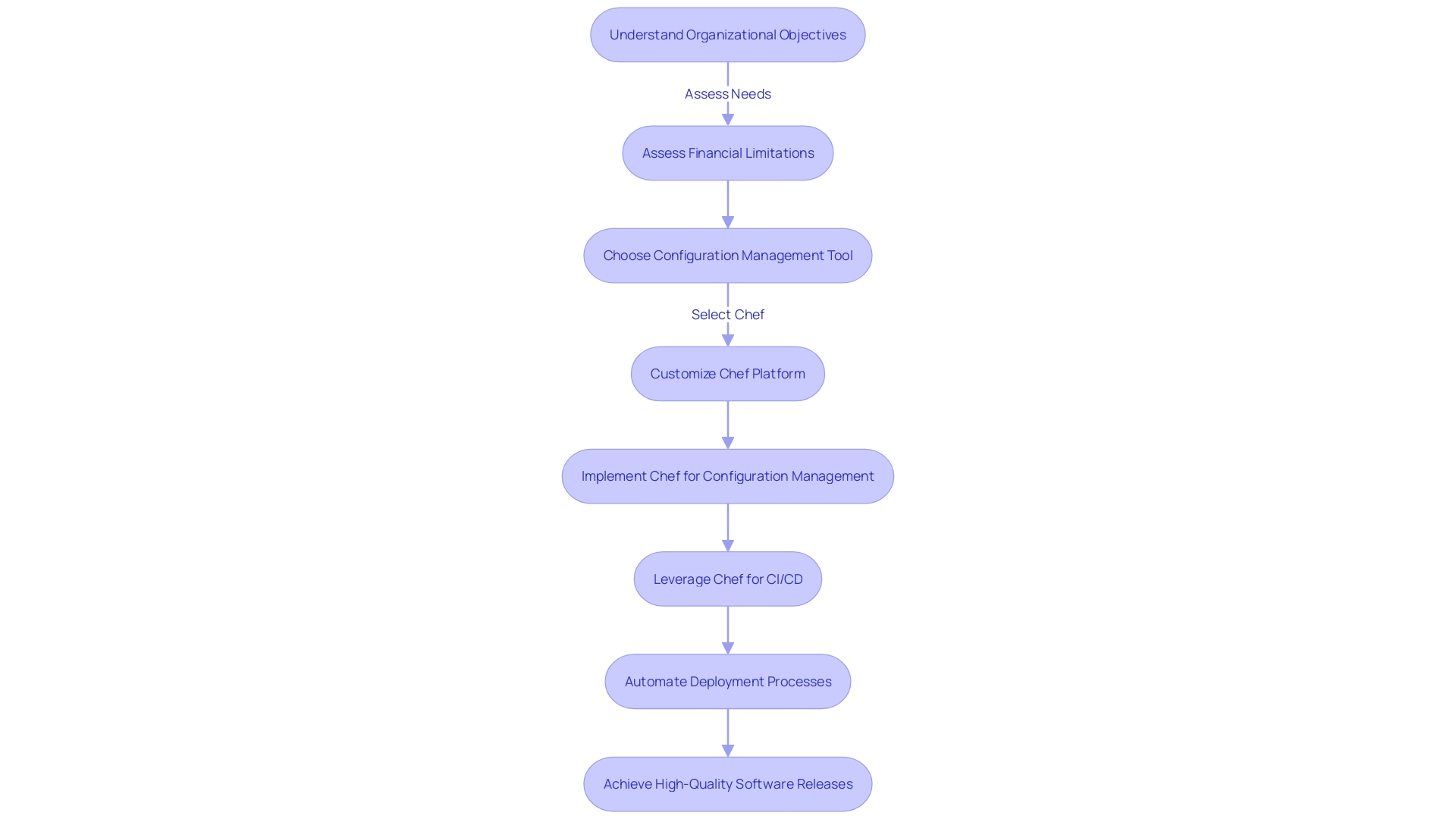
Puppet: An Open-Source Deployment Tool for DevOps
By utilizing Puppet's code-based capabilities, organizations are greatly enhancing their development and operations. Puppet, providing a declarative syntax, allows teams to define infrastructure requirements while the software autonomously ensures these conditions are met across servers and network devices, maintaining consistency and compliance with established policies. This approach is integral for DevOps practices, which emphasize the importance of automation in the software development lifecycle (SDLC), bridging gaps between development, operations, and other business units. The application of continuous integration and delivery, along with monitoring and logging, has been pivotal in reducing overhead and accelerating market readiness.
Recent industry developments highlight Puppet's role in enhancing platform engineering's efficacy. A survey conducted by Puppet in the summer of 2023 with 474 participants revealed that platform engineering, when standardized through systems like Puppet, not only saves costs and development time but also minimizes errors and security breach risks. Puppet's Vice President of Product Management, Kapil Tandon, highlighted the democratization of security responsibilities, stating, 'With secure features integrated into most platforms, platform engineering is enabling more individuals than ever to assume accountability for security.'
The positive reception of Puppet extends to its ease of use and the powerful concept of a Puppet Master—the central server that disseminates configurations to Puppet agents. As organizations shift from intricate operations to agile, continuous delivery, solutions like Puppet are at the forefront, playing a vital role in streamlining processes and supporting green energy initiatives, as demonstrated by global leaders like Bosch. The move towards efficient, sustainable solutions is reflected in the adoption of such tools, which are essential in the pursuit of a cleaner, greener, and more productive technological ecosystem.
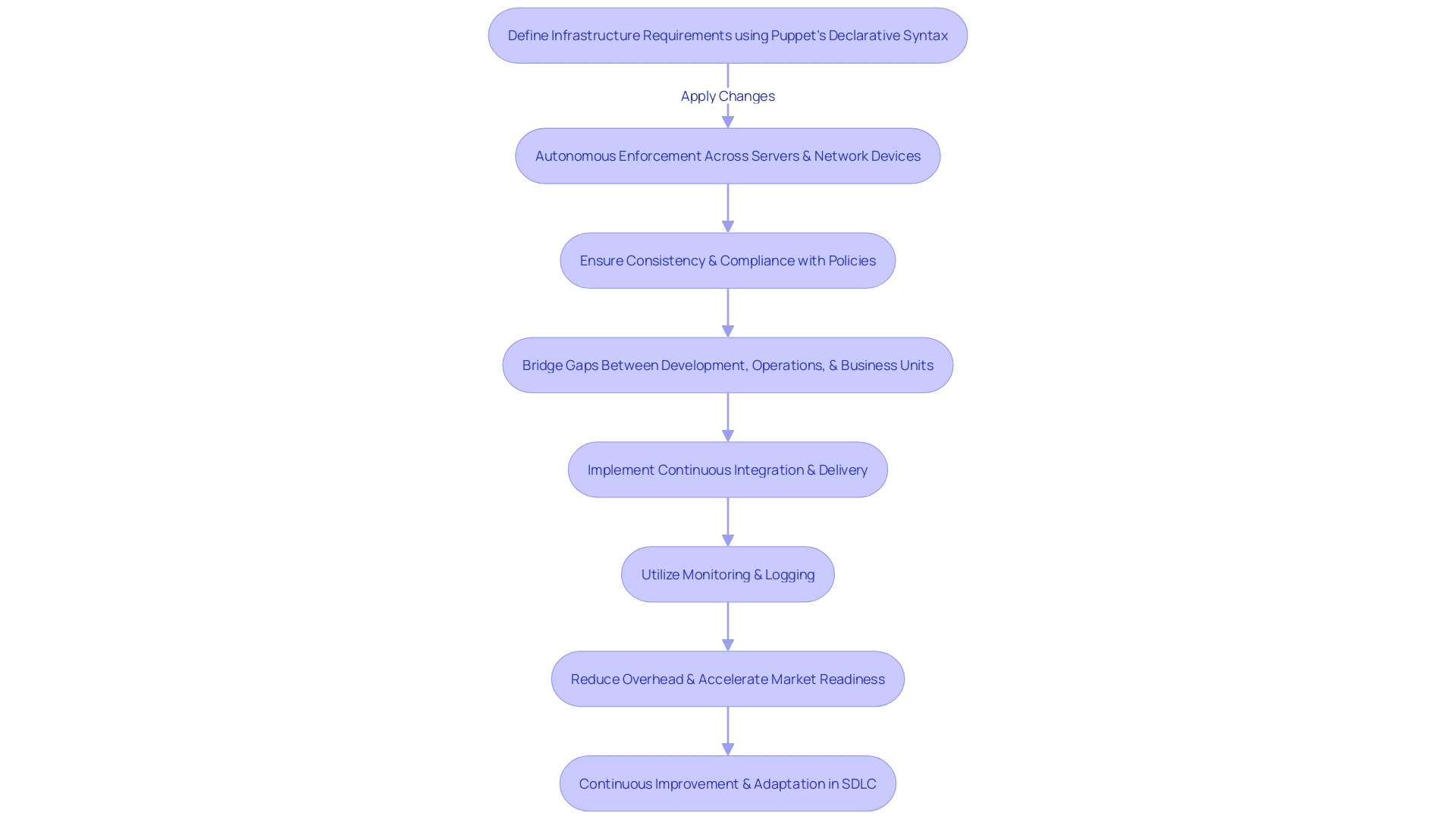
Jenkins: A Continuous Integration and Delivery Tool
Harnessing the power of Jenkins offers a transformative approach to automating software development processes. As an open-source server, Jenkins plays a pivotal role in both Continuous Integration (CI) and Continuous Deployment (CD), streamlining the development lifecycle by automating builds, tests, and deployments. This automation facilitates a more consistent and reliable release process while minimizing manual errors.
'Jenkins' compatibility with various version control systems, such as Git, Subversion, and Mercurial, underscores its versatility and capacity to integrate seamlessly into different environments.'. The platform's extensibility allows for customized adaptation of the CI/CD pipeline to meet the specific needs of any MERN application development project.
The commitment to frequent and automated integration of code changes into a shared repository reduces the risk of conflicts and enables more frequent testing. This 'commit early, push often' philosophy is essential to circumventing 'Merge Hell,' ensuring that the software remains in a deployable state at all times.
A recent survey conducted by the Linux Foundation Research, covering cloud native computing and associated technologies, highlights the growing adoption of such native techniques. With data collected from diverse industries and regions, the insights point to an increasing reliance on automated and efficient software development practices.
In the realm of software engineering, Jenkins has established itself as a cornerstone, with Thoughtworks and other leading global technology consultancies advocating for its integration into digital strategies. The ability to automate and monitor the execution of jobs not only optimizes the development process but also aligns with the industry's movement towards innovation and agility.
As we delve into the features and practical applications of Jenkins, it is essential to recognize the historical context of its creation. Born out of a need to enhance build stability and developer integration, Jenkins (originally known as 'Hudson') has evolved into a tool that is integral to modern DevOps practices, supporting the agile transformation of technology teams around the world.
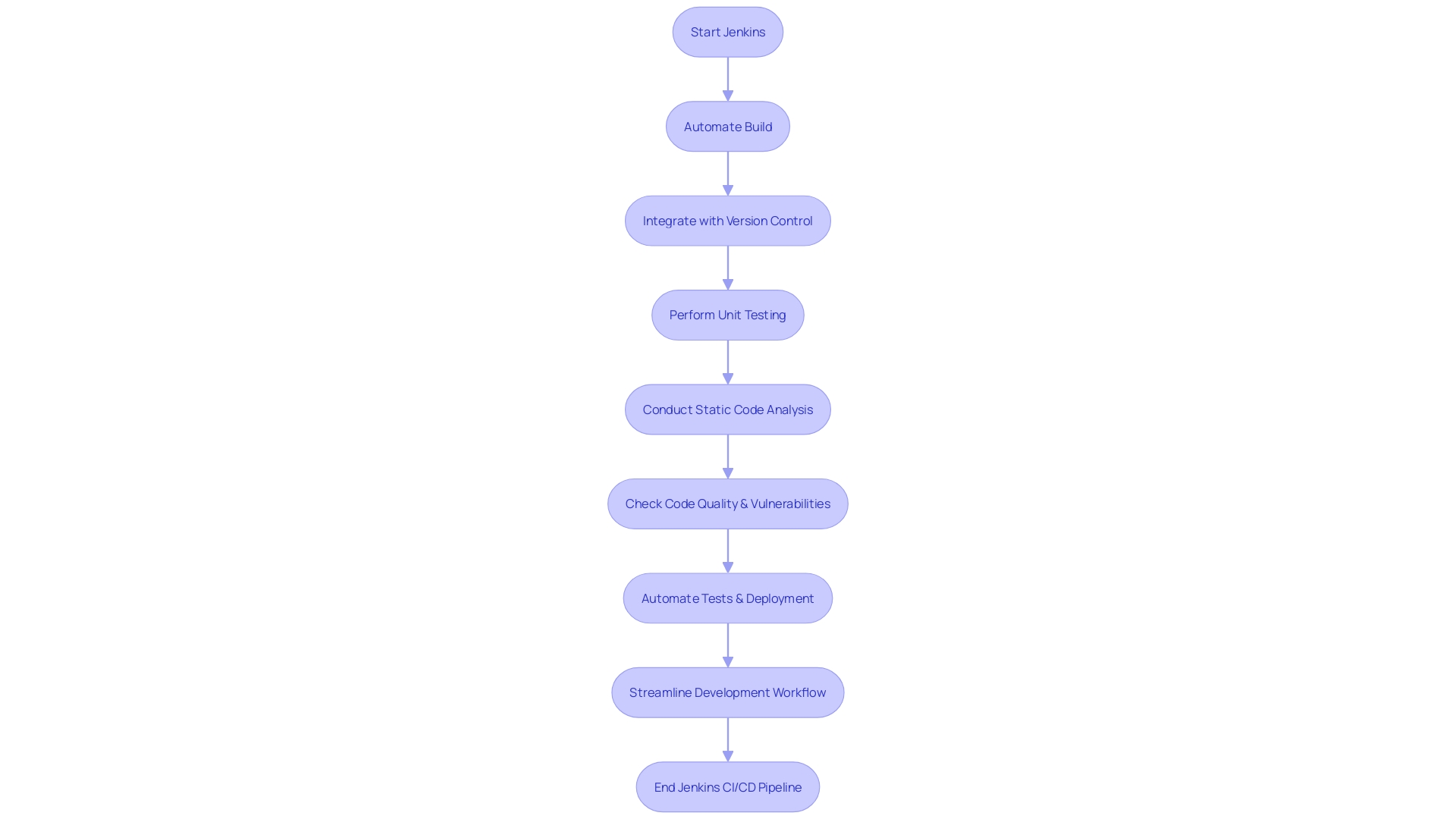
Azure Automation: A Cloud-Based Automation Solution
Microsoft Azure provides enterprises with a strong cloud service to streamline the orchestration and management of their Azure resources. By harnessing the capabilities of Azure Automation, businesses can construct and implement runbooks that automate routine operations, strategically schedule script executions, and establish comprehensive integrations with other Azure offerings to foster a cohesive and automated workflow ecosystem. This strategic process enables organizations not only to enhance operational efficiency but also to nimbly adapt to the evolving demands of the digital landscape. As the Market for Industrial Automation Services is projected to expand significantly, rising from $147.06 Billion in 2019 to $264.69 Billion by 2026, the use of such technology becomes increasingly critical. Azure Automation, specifically, offers a pathway to automate essential tasks including provisioning, configuration, and recovery, which are pivotal for maintaining a competitive edge in a market where an estimated 83% of IT leaders assert that workflow automation is essential for digital transformation. Furthermore, with insights from the Microsoft Fabric Community Conference, it's clear that integrating data sources and analytics services on a unified AI-powered platform like Azure is key to unlocking new levels of productivity and business intelligence.
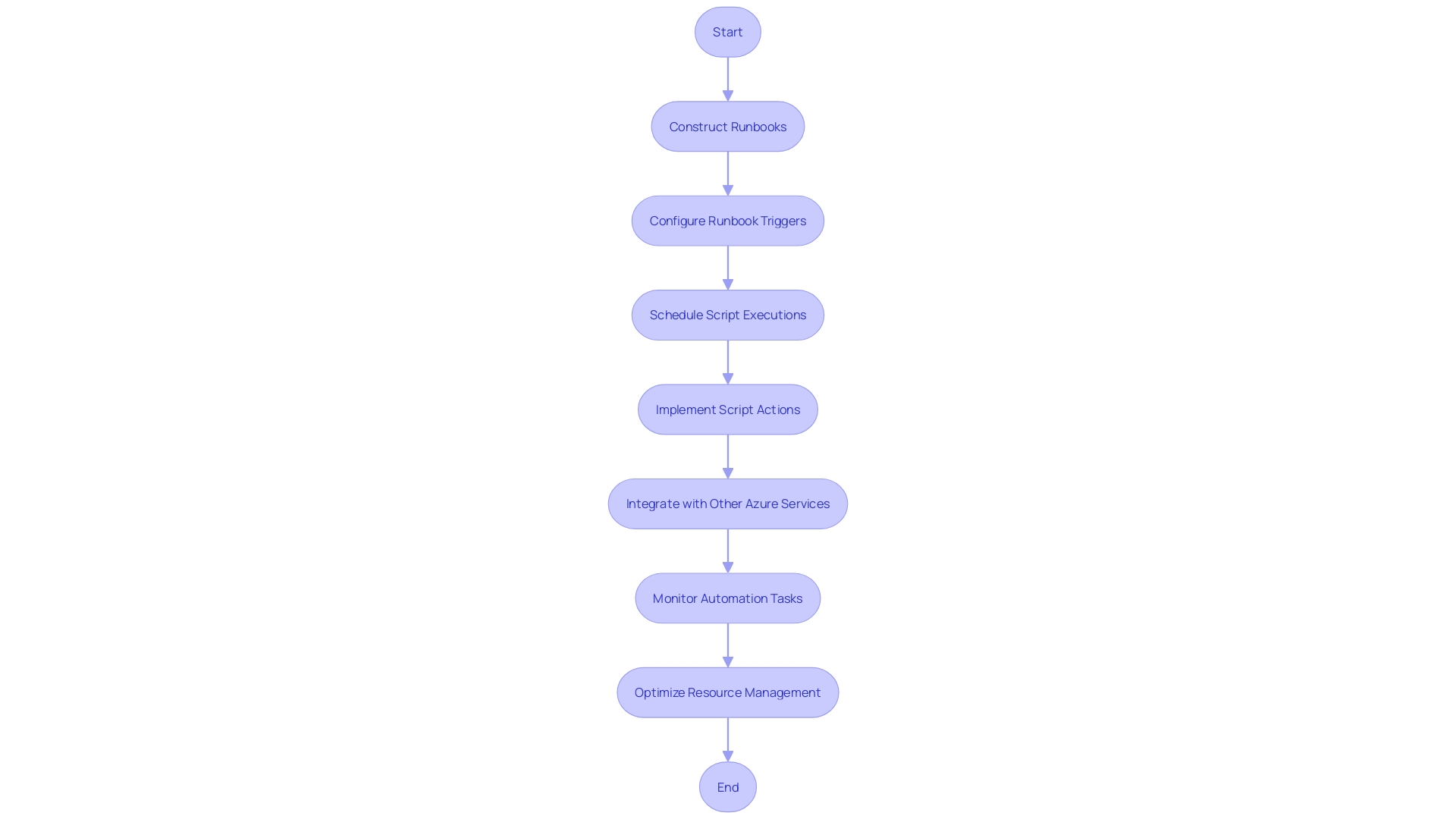
Terraform: An Infrastructure as Code (IaC) Cloud Automation Solution
Terraform, a tool developed by HashiCorp, harnesses the power of Infrastructure as Code (IAC) to enable a seamless, automated approach to provisioning and managing resources. Using its declarative configuration files, Terraform enables the clear definition and provisioning of resources across multiple cloud providers. This utility is particularly beneficial for organizations seeking to scale efficiently, as it transitions them from labor-intensive, manual provisioning to a more streamlined, error-resistant, and collaborative management process.
The significance of Terraform is further highlighted by its widespread adoption. It skillfully tackles a common scenario encountered by expanding companies, where the intricacy and frequency of manual system management can result in inefficiencies and increased error rates. By standardizing and simplifying configuration, Terraform facilitates scalability with minimal effort, a feature that resonates with the needs of dynamic organizations.
Moreover, Terraform's modular approach to project structure exemplifies its flexibility. By compartmentalizing different units of code into subfolders, with a main. Tf file serving as the integration point, it allows for a clear, structured, and maintainable codebase. This modular design promotes the use of reusable components, such as application and system modules, which can be defined once and integrated into multiple projects.
The significance of Terraform in contemporary cloud resource management is emphasized by its design principles, which prioritize managing resources on any cloud or platform, defining the structure through declarative code, and predictably managing resource lifecycles. Organizations have come to rely on Terraform's provider-agnostic capabilities and its ability to facilitate a repeatable, error-minimized deployment process that upholds consistency across development, testing, and production environments.
In light of these capabilities, it is not surprising that Terraform has carved out a significant market position among IAC tools. However, it's worth noting that HashiCorp's decision to change Terraform's license type has taken it off the open-source market. This shift has sparked discussions regarding cost and resource management, prompting some organizations to reassess their use of Terraform in light of alternative IaC solutions.
As the scenery of IaC advances, Terraform still maintains a crucial position, showcasing the transformative effect of automating management for agile and scalable technology operations.
Cast AI: A Kubernetes Automation Platform for Cost Optimization
Leveraging the power of artificial intelligence, Cast AI presents an innovative solution for optimizing Kubernetes clusters, addressing the critical need for cost-efficiency and performance in the cloud. With the ability to dynamically right-size and auto-scale resources in response to real-time demand, Cast AI ensures that organizations utilize their infrastructure most effectively, preventing both over-provisioning and under-utilization, which are common pitfalls that can lead to spiraling expenses.
As companies face the pressure to rationalize their technology stacks and cut costs, tools like Cast AI are invaluable. They automate what has conventionally been a manual and error-prone process, contributing to a more efficient data-to-insights lifecycle. The platform's AI-driven algorithms can react instantaneously to changes in demand, offering a strategic advantage in an economic landscape where agility and innovation are paramount.
The benefits of such automation are underscored by industry leaders who recognize the necessity of integrating advanced technologies like Cast AI to remain competitive. As digital environments grow increasingly intricate, the capability to handle expenses without compromising on the scalability or availability of applications is crucial. With Cast AI, businesses are well-equipped to navigate the balance of expanding their cloud footprint while maintaining financial prudence, ensuring they can leverage the full spectrum of cloud value, from IT productivity to business innovation.
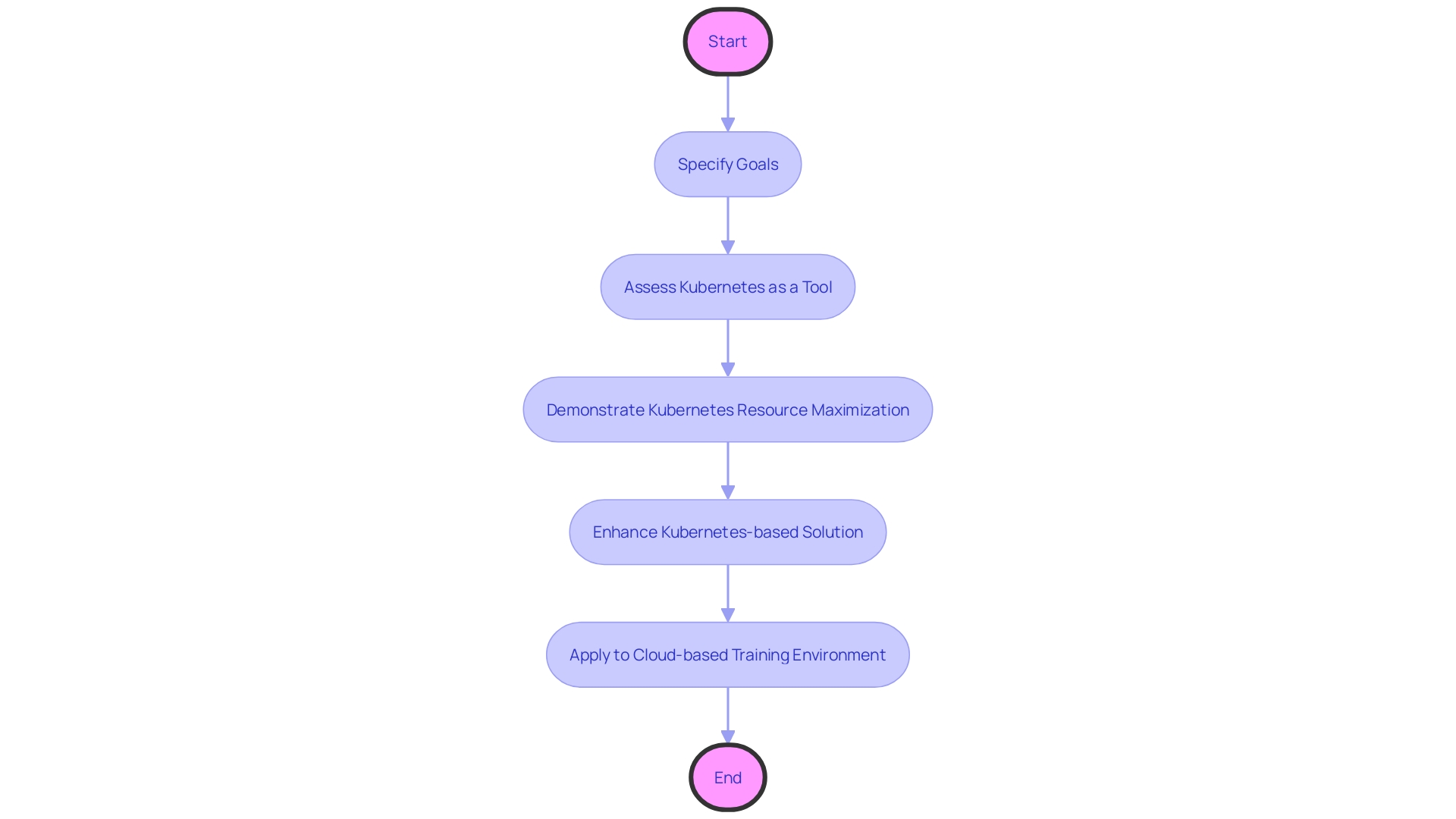
SaltStack: A Python-Based Open-Source Configuration Management Tool
The need for efficient configuration management tools in DevOps environments has become more and more crucial, particularly for large-scale organizations that handle intricate systems. SaltStack, with its Python-based declarative language, provides a strong solution for defining the structure as code, enabling the streamlining of configuration and management of the physical environment. For instance, the Central and North West London NHS Foundation Trust, which oversees a vast array of health care services, requires a streamlined and reliable method to handle their technology needs across multiple sites. SaltStack's event-driven architecture is particularly beneficial in such scenarios, as it allows for real-time response to infrastructure events, a feature that is vital for organizations where consistent access to critical services is paramount.
Moreover, the remote execution capabilities of SaltStack provide a level of versatility that is advantageous for companies like Tabcorp, Australia's largest provider of wagering and gaming products, which faced a maze of development and deployment challenges due to the diverse nature of their teams and services. The ability to manage and automate tasks across different environments can significantly reduce inconsistencies and streamline processes.
As the industry moves forward, the Open Infrastructure Foundation highlights the importance of open source communities and the continuous improvement of software like OpenStack, which aligns with the philosophy of SaltStack. Open source solutions such as SaltStack not only offer customization and adaptability but also ensure that organizations can keep their systems up to date with modern requirements.
With JavaScript and Python being the most popular programming languages among developers in 2023, the Python-based language of SaltStack is well-positioned in the market, facilitating a smoother transition for teams already proficient in these languages. Moreover, the move towards major cloud services, with Amazon Web Services at the forefront, emphasizes the importance of cloud automation solutions that can smoothly integrate and function within these ecosystems.
In summary, SaltStack stands out as a scalable and efficient platform for managing complex environments, and its alignment with current technological trends and best practices in DevOps makes it an indispensable tool for organizations pursuing agile transformation and innovation.
Conclusion
In conclusion, Zeet offers organizations a comprehensive CI/CD deployment platform that accelerates software delivery and enables continuous delivery. By automating workflows across building, testing, and deployment, Zeet ensures faster and more consistent software iterations. Its integrated CI/CD capabilities enhance the efficiency and reliability of development operations, making it an instrumental ally in the journey towards cloud native maturity.
Zeet's CI/CD capabilities are particularly valuable in industries such as banking, where swift, secure, and compliant software releases are paramount. Zeet meets stringent standards for code quality and regulatory compliance without sacrificing speed to market. Additionally, Zeet plays a crucial role in consolidating and simplifying various stages of development, enhancing developer experience and productivity.
Overall, Zeet has the potential to transform enterprises into agile and value-driven organizations by facilitating flexible and continuous delivery of value. Its automation features streamline processes, reduce human error, standardize configurations, and support scalability. By leveraging Zeet, organizations can embrace the shift towards efficient, sustainable solutions and maintain a competitive edge in today's dynamic market.
In conclusion, Zeet is a trusted and reliable platform that empowers organizations to refine their software development lifecycle and achieve continuous delivery. With its suite of features and integrated CI/CD capabilities, Zeet accelerates software delivery, enhances efficiency, and enables organizations to become agile and value-driven.




